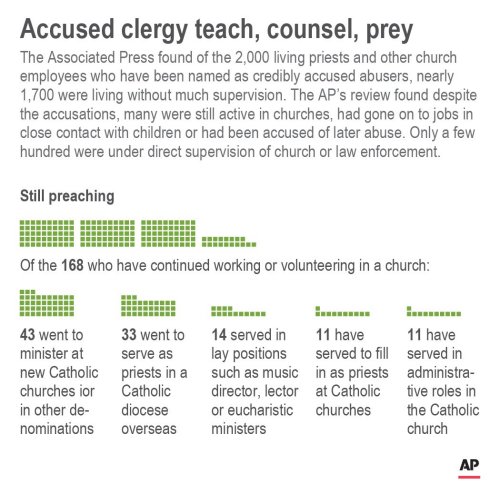
Without oversight, scores of accused priests commit crimes
SOURCE
Nearly 1,700 priests and other clergy members that the Roman Catholic Church considers credibly accused of child sexual abuse are living under the radar with little to no oversight from religious authorities or law enforcement, decades after the first wave of the church abuse scandal roiled U.S. dioceses, an Associated Press investigation has found.
These priests, deacons, monks and lay people now teach middle-school math. They counsel survivors of sexual assault. They work as nurses and volunteer at nonprofits aimed at helping at-risk kids. They live next to playgrounds and day care centers. They foster and care for children.
And in their time since leaving the church, dozens have committed crimes, including sexual assault and possessing child pornography, the AP’s analysis found.
A recent push by Roman Catholic dioceses across the U.S. to publish the names of those it considers to be credibly accused has opened a window into the daunting problem of how to monitor and track priests who often were never criminally charged and, in many cases, were removed from or left the church to live as private citizens.
Each diocese determines its own standard to deem a priest credibly accused, with the allegations ranging from inappropriate conversations and unwanted hugging to forced sodomy and rape.
Dioceses and religious orders so far have shared the names of more than 5,100 clergy members, with more than three-quarters of the names released just in the last year. The AP researched the nearly 2,000 who remain alive to determine where they have lived and worked — the largest-scale review to date of what happened to priests named as possible sexual abusers.
In addition to the almost 1,700 that the AP was able to identify as largely unsupervised, there were 76 people who could not be located. The remaining clergy members were found to be under some kind of supervision, with some in prison or overseen by church programs.
The review found hundreds of priests held positions of trust, many with access to children. More than 160 continued working or volunteering in churches, including dozens in Catholic dioceses overseas and some in other denominations. Roughly 190 obtained professional licenses to work in education, medicine, social work and counseling — including 76 who, as of August, still had valid credentials in those fields.
The research also turned up cases where the priests were once again able to prey upon victims.
After Roger Sinclair was removed by the Diocese of Greensburg in Pennsylvania in 2002 for allegedly abusing a teenage boy decades earlier, he ended up in Oregon. In 2017, he was arrested for repeatedly molesting a young developmentally disabled man and is now imprisoned for a crime that the lead investigator in the Oregon case says should have never been allowed to happen.
Like Sinclair, the majority of people listed as credibly accused were never criminally prosecuted for the abuse alleged when they were part of the church. That lack of criminal history has revealed a sizable gray area that state licensing boards and background check services are not designed to handle as former priests seek new employment, apply to be foster parents and live in communities unaware of their presence and their pasts.
It also has left dioceses struggling with how — or if — former employees should be tracked and monitored. While victims’ advocates have pushed for more oversight, church officials say what’s being requested extends beyond what they legally can do. And civil authorities like police departments or prosecutors say their purview is limited to people convicted of crimes.
That means the heavy lift of tracking former priests has fallen to citizen watchdogs and victims, whose complaints have fueled suspensions, removals and firings. But even then, loopholes in state laws allow many former clergy to keep their new jobs even when the history of allegations becomes public.
“Defrocked or not, we’ve long argued that bishops can’t recruit, hire, ordain, supervise, shield, transfer and protect predator priests, then suddenly oust them and claim to be powerless over their whereabouts and activities,” said David Clohessy, the former executive director of the Survivors Network of those Abused by Priests, who now heads the group’s St. Louis chapter.
“IT WAS SUPPOSED TO MAKE ABUSE HISTORY”
When the first big wave of the clergy abuse scandal hit Roman Catholic dioceses in the early 2000s, the U.S. bishops created the Dallas Charter, a baseline for sexual abuse reporting, training and other procedures to prevent child abuse. A handful of canon lawyers and experts at the time said every diocese should be transparent, name priests that had been accused of abuse and, in many cases, get rid of them.
Most dioceses decided against naming priests, however. And with the dioceses that did release lists in the next few years— some by choice, others due to lawsuit settlements or bankruptcy proceedings — abuse survivors complained about underreporting of priests, along with the omission of religious brothers they believed should be on those lists.
Full Coverage: The Reckoning
“The Dallas Charter was supposed to fix everything. It was supposed to make the abuse scandal history. But that didn’t happen,” said the Rev. Thomas Doyle, a canon lawyer who had tried to warn the bishops that abuse was widespread and that they should clean house.
After the charter was established in 2002, some critics say dioceses were more likely to simply defrock priests and return them to private citizenship.
Before 2018′s landmark Pennsylvania grand jury report, which named more than 300 predator priests accused of abusing more than 1,000 children in six dioceses, the official lists of credibly accused priests added up to fewer than 1,500 names nationwide. Now, within the span of a little more than a year, more than 100 dioceses and religious orders have come forward with thousands of names — but often little other information that can be used to alert the public.
CLICK HERE TO CONTINUE ARTICLE
